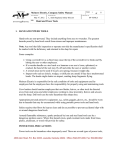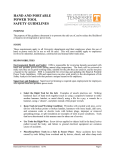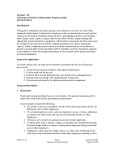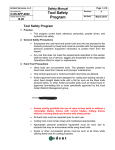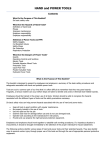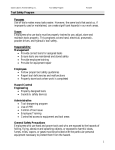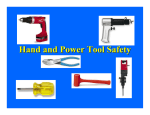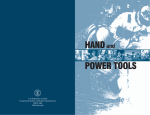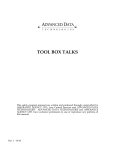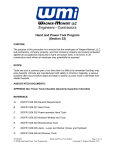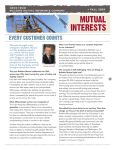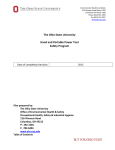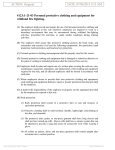Download HAND & POWER TOOLS - SeaBright Insurance
Transcript
Supervisors’ Safety Update SSU 2010-03 HAND & POWER TOOLS By SeaBright Insurance Loss Control ools are such a common part of our lives we often forget that they may be hazardous. While all tools are manufactured with “safety in mind”, tragically, serious incidents often occur before steps are taken to identify, avoid or eliminate tool-related hazards before an incident occurs. Tools help us to easily perform tasks that otherwise would be difficult or impossible. However, special attention toward hand and power tool safety is necessary in order to reduce or eliminate these hazards. Employees must be trained in the proper use of all tools. They must learn to recognize the hazards associated with the different types of tools and the safety precautions necessary to prevent injuries to themselves or others. In addition, employees who use hand and power tools can also be exposed to the hazards of falling, flying, abrasive and splashing objects, or to harmful dusts, fumes, mists, vapors or gases. Employees must be provided with the appropriate personal protective equipment necessary to prevent tool-related injures. Remember to: Keep all tools in good condition with regular maintenance. Use the right tool for the job. Examine each tool for damage before use. Operate according to the manufacturer' s instructions. Provide and use the right protective equipment. Employees and employers have a responsibility to work together to establish safe working procedures. If a hazardous situation is encountered, it should be brought immediately to the attention of the supervisor in charge. The following sections identify various types of tools, their potential hazards, and ways to prevent worker injury through their proper use and the use of appropriate personal protective equipment. The materials contained in this update are not intended as legal, business, or risk management advice to any party, and in no way represent advice with respect to specific practices of any party or any undertaking by SEABRIGHT INSURANCE COMPANY in any regard. SEABRIGHT has not confirmed or verified the accuracy or correctness of such materials or any information on which they may be based and makes no representation or warranty as to the content of this update or its accuracy, or its appropriateness or its suitability for any particular reader, situation or practice, or as to conformance with applicable laws or regulations. Readers should conduct and rely on their own investigations before acting upon or otherwise using such materials. Questions about this material should be addressed in writing to the loss control department, SeaBright Insurance Company, Suite 1600, 2101 4th Avenue, Seattle, WA 98121, or by email to [email protected]. Hand Tools Hand tools are non-powered. They include anything from axes to wrenches. The greatest hazards posed by hand tools result from misuse and improper maintenance. For example, misused screwdrivers alone are responsible for more injuries than all other hand tools grouped together. Before hand tools are selected or used they must be checked to ensure they are in good condition and proper for the task planned. Questions that should be asked before using a tool include: Are both company and employee owned tools and equipment in good condition? Have chisels or punches that developed mushroomed heads during use? Who should be contacted to get them reconditioned or replaced? Have all broken or fractured handles on hammers, axes and similar equipment been replaced? Are tool handles wedged tightly in the head of all tools? Are wrenches that are bent or worn replaced or traded-in timely? When was the last training conducted on hand tools? Are your company employees aware of the hazards caused by faulty or improperly used tools? Employees who use equipment which might produce flying materials or be subject to breakage must wear appropriate safety glasses, face shields, etc. Is there plenty of this PPE in stock? Are jacks, come-a-longs and other daily use equipment checked periodically to ensure they are in good operating condition? Are tool cutting edges kept sharp so the tool will move smoothly without binding or skipping? Is eye and face protection used when driving hardened or tempered spuds or nails? Employees are responsible for only using properly maintained tools that are correct for the task. But training must continually be done to keep awareness up on the subject. Caution employees that saw blades, knives, or other tools be directed away from aisle areas and other employees working in close proximity. Knives and scissors must be sharp. Dull tools can be more hazardous than sharp ones because more force is required. Safety requires that floors be kept as clean and dry as possible to prevent accidental slips with or around dangerous hand tools. Sparks produced by iron or steel hand tools can be a dangerous ignition source around flammable substances. Where this hazard exists, spark-resistant tools made from brass, plastic, aluminum, or wood will provide a higher level of safety. Power Tools Power tools are typically categorized by their power source: electric, pneumatic, liquid fuel, hydraulic, and powderactuated. Each of the tools and its power source creates hazards that must be understood and controlled. And like any tool they can be hazardous when used improperly. Because of the wide variety of power tools in the industrial, commercial and residential marketplace today, the most appropriate way to learn of the precautions and hazards is to read and follow the manufacturer’s owners’ manual. While each tool has its own specific safety precautions, warnings and hazards your workers can learn from these general precautions as well: Remember that the operator of a power tool has control of their work area. Keep all observers at a safe distance with respect to the tool to avoid injuries to others. Secure the work using equipment such as clamps or a vise. This frees both hands to operate the tool. Whenever possible disconnect or power-down equipment when carrying it. Avoid accidental starting, by not keeping a finger on or near the switch button while carrying a plugged-in tool. One slip or trip and the equipment would be powered up, at the same time one may loose their balance. Carrying a tool by the cord or hose damages or prematurely wears the connection to the equipment, creating a hazard for the user. Like carrying a tool by the cord, yanking the cord or the hose to disconnect it from the receptacle, puts strain on the connection and cord that it was not designed to accept. Grinders, saws and similar equipment come from the manufacturer with appropriate safety guards. Ensure your employees installed this safety equipment and use the supplied shield, guard, or attachment that is recommended for the task. Follow the user' s manual instructions for maintaining, lubricating and changing accessories. Before servicing, make sure tools are in a "zero mechanical state" (ZMS), including whenever an accessory, blade, bit, or cutter must be changed. Maintain every tool with care. Keep tools sharp and clean for best performance. Sharp, well-maintained tools are safe tools. Are ground-fault circuit interrupters provided on all temporary electrical 15 and 20-ampere circuits, used during periods of construction? Are all cord-connected, electrically operated tools and equipment effectively grounded or of the approved double insulated type? Are portable circular saws equipped with guards above and below the base shoe? Are circular saw guards checked to assure they are not wedged, thus leaving the lower portion of the blade unguarded? Are effective guards in place over belts, pulleys, chains, sprockets, on equipment such as concrete mixers, and air compressors? Are rotating/moving parts guarded to prevent physical contact? Are pneumatic & hydraulic hoses on power-operated tools checked regularly for deterioration/damage? Wear proper apparel for the task. Loose clothing. Ties or jewelry can become caught in moving parts. Guards and Safety Switches If a worker or bystander can potentially be caught or snagged in a belt, gear, shaft, pulley, sprocket, spindle, drum, flywheel, chain, or other reciprocating, rotating, or moving part it must be guarded. Removing safety guards on portable power equipment is a very common unsafe act enacted by employees, who believe that the safety device is un-needed or impedes the work. Guards are installed to protect the worker and must remain in place if employees have the potential to come into contact with them. Guards should always be considered at these locations: Point of operation In-running Nip Points Rotating parts Flying chips and sparks Safety guards must never be removed when a tool is being used. For example, circular saws must be equipped at all times with guards. An upper guard must cover the entire blade of the saw. A retractable lower guard must cover the teeth of the saw, except when it makes contact with the work material. The lower guard must automatically return to the covering position when the tool is withdrawn from the work. The majority of hand-held powered tools must be equipped with a momentary contact "on-off" control switch. Equipment such as: drills; drill/drivers; horizontal, vertical and angle grinders with wheels larger than 2 inches diameter; disc sanders, belt sanders; reciprocating saws; saber saws; and other similar tools must have the shut off. Many styles of these tools are also equipped with a "lock-on" control. This control can be used if it allows the worker to shut off the control in a single motion using the same finger or fingers that operate the power. Certain hand-held powered tools may be equipped with only a positive "on- off'control switch. Examples of these are: plate sanders; disc sanders with discs 2” or less in diameter grinders with wheels 2” or less in diameter; routers; planers; laminate trimmers; nibblers; shears; scroll saws; and jigsaws with blade shanks ¼” wide or less. Other hand-held powered tools, such as circular saws having a blade diameter greater than 2,” chain saws, and percussion tools that cannot be held easily, must be equipped with a constant pressure switch that will shut off the power when that pressure is released. If you find the switch defeated and in a constant “on” position by tape or zip-ties or methods, it should be corrected immediately. There is a reason why the manufacturer did not produce the equipment with “lock-on” or positive “on-off” switch. Defeating such a safe guard is placing your workers potentially in harms way. Electric Tools Employees using electric tools must be aware of several dangers; the most serious is the possibility of electrocution. Burns and slight shocks, which can lead to injuries or even heart failure, are among the major hazards associated with electric-powered tools. Under certain conditions, even small amounts of current can result in fibrillation of the heart and eventual death. A shock also can cause the user to fall off a ladder or other elevated work surfaces. To protect the user from shock, tools must have either a three-wire cord with ground and be grounded, be double insulated, or be powered by a low-voltage isolation transformer. Three-wire cords contain two current-carrying conductors and a grounding conductor. One end of the grounding conductor connects to the tool' s metal housing. The other end is grounded through a prong on the plug. Any time an adapter is used to accommodate a two-hole receptacle, the adapter wire must be attached to a known ground. The third prong should never be removed from the plug. Double insulation is more convenient. The user and the tools are protected in two ways: by normal insulation on the wires inside and by a housing that cannot conduct electricity to the operator in the event of a malfunction. A ground fault circuit interrupter (GFCI) is required for portable electrical power tool use on all construction sites, or an assured grounding conductor program must be in place. Remember, no matter what the precise code wording may be, the use of GFCI' s is exercising common sense that you will never have to defend. Always err on the side of safety whenever you are in doubt. These general practices should be followed when using electric tools: Operate electric tools within their design limitations. Use gloves and safety footwear when using electric tools. Store tools in a dry place when not in use. Do not use electric tools in damp or wet locations. Keep work areas well lighted. Do not allow cords to present a tripping hazard. Replace damaged, cut or frayed cords and defective switches. Remove all damaged portable electric tools from use and tag them “Do not use.” Powered Abrasive Wheel Tools Powered abrasive grinding, cutting, polishing, and wire buffing wheels create special safety problems because they may throw off flying fragments. Before an abrasive wheel is mounted, it should be inspected closely and should be sound or ring-tested to ensure that it is free from cracks or defects. To test, wheels should be tapped gently with a light non-metallic instrument. If they sound cracked or dead, they must not be used because they could fly apart in operation. A sound and undamaged wheel will give a clear metallic tone or "ring." To prevent the wheel from cracking, the user should be sure it fits freely on the spindle. The spindle nut must be tightened enough to hold the wheel in place, without distorting the flange. Follow the manufacturer' s recommendations. Care must be taken to ensure that the spindle wheel will not exceed the abrasive wheel specifications. The wheel may disintegrate or explode during start-up. The employee should never stand directly in front of the wheel as it accelerates to full operating speed because portable grinding tools need to be equipped with safety guards to protect workers not only from the moving wheel surface, but also from flying fragments in case of breakage. In addition, when using a powered grinder: Always use eye protection Turn off the power when not in use, and Never clamp a hand-held grinder in a vise. Pneumatic Tools Pneumatic tools are powered by compressed air and include chippers, drills, hammers, and sanders. There are several potential dangers associated with the use of pneumatic tools. The main one is the danger of getting hit by one of the tools attachments or by some kind of fastener the worker is using with the tool. Pneumatic tools that shoot nails, rivets, or staples, and operate at pressures more than 100 pounds per square inch, must be equipped with a special device to keep fasteners from being ejected unless the muzzle is pressed against the work surface, Eye protection is required and face protection is recommended for employees working with pneumatic tools. Noise is another hazard. Working with noisy tools such jackhammers requires proper, effective use of appropriate hearing protection. When using pneumatic tools, employees must check to see that they are fastened securely to the air hose to prevent them from being disconnected. A short wire or positive locking device attaching the air hose to the tool will serve as an added safeguard. Airless spray guns that atomize paints and fluids at high pressures (1,000 psi or more) must be equipped with automatic or visual manual safety devices that will prevent pulling the trigger until the safety device is manually released. If an air hose is more than ½” diameter, a safety excess flow valve must be installed at the source of the air supply to shut off the air automatically in case the hose breaks. In general, the same precautions should be taken with an air hose that are recommended for electric cords, because the hose is subject to the same kind of damage. A safety clip or retainer must be installed to prevent attachments, such as chisels on a chipping hammer, from being unintentionally shot from the barrel. Screens must be set up to protect nearby workers from being struck by flying fragments around chippers, riveting guns, staplers, or air drills. Compressed air guns should never be pointed toward anyone, Users should never "dead-end" them against themselves or anyone else. Heavy jackhammers can cause fatigue and strains; heavy rubber grips reduce these effects by providing a secure handhold. Workers operating a jackhammer must wear safety glasses and safety shoes, which protects against injury if the hammer slips or falls. A face shield also should be used. Gas Fueled Powered Tools Fuel-powered tools are usually operated on gasoline or mixture of gas and oil. Over the past few years these tools have become more prevalent and more powerful. According to NIOSH the most serious hazard with gasoline-powered tools comes from fuel vapors that can burn or explode and gives off dangerous exhaust fumes. It is not widely known that small gasoline-powered engines and tools present a health hazard. They produce high concentrations of Carbon Monoxide -- a poisonous gas that can cause illness, permanent neurological damage, and death. Because it is colorless, odorless, and nonirritating, CO can overcome exposed persons without warning. Often there is little time before they experience symptoms that inhibit their ability to seek safety. Prior use of equipment without incident has sometimes given users a false sense of safety; such users have been poisoned on subsequent occasions. Recommendations for preventing CO poisoning are provided below: • Do NOT operate gasoline-powered engines or tools inside buildings or in partially enclosed areas unless gasoline engines can be located outside away from air intakes. Use of gasoline-powered tools indoors where CO from the engine can accumulate can create a serious health hazard. • Always place the pump and power unit of high-pressure washers outdoors and away from air intakes so that engine exhaust is not drawn indoors where the work is being done. Run only the high-pressure wash line inside. • Learn to recognize the symptoms and signs of CO overexposure: headache, nausea, weakness, dizziness, visual disturbances, changes in personality, and loss of consciousness. Any of these symptoms and signs can occur within minutes of usage. If compressed air is used, place the gasoline-powered compressor outdoors and away from air intakes so that engine exhaust is not drawn indoors where the work is being done. The worker must be careful to handle, transport, and store the fuel only in approved flammable liquid containers and according to company policy. Before the tank for a fuel-powered tool is refilled, first shut down the engine and allow it to cool to prevent accidental ignition. If fuel-powered tools are used inside a closed area, effective ventilation and/or personal protective equipment is necessary to avoid carbon monoxide. Fire extinguishers must also be available in the area. Powder-Actuated Tools Powder-actuated tools operate like a loaded gun and should be treated with the same respect and precautions. In fact they are so dangerous that they must be operated only by specially trained and certified employees. Suitable ear, eye, and face protection are essential when using powder-actuated tools. All powder-actuated tools must be designed for varying powder charges so that the user can select a powder level necessary to do the work without excessive force. The muzzle end of the tool must have a protective shield or guard centered perpendicularly on the barrel to confine any flying fragments or particles that might otherwise create a hazard when the tool is fired. To prevent the tool from firing accidentally, two separate motions are required. The first is to bring the tool in position and another to pull the trigger. The tool must not be able to operate until it is pressed against the work surface with a force of at least 5 pounds greater than the total weight of the tool. If a powder-actuated tool misfires, the user should wait at least 30 seconds, then try firing it again. If it still will not fire, the user should wait another 30 seconds so that the faulty cartridge is less likely to explode, then carefully remove the load. The bad cartridge should be put in water. If the tool develops a defect during use, it should be tagged and taken out of service immediately until it is properly repaired. Safety precautions to remember when using powder-actuated tools include the following: • Personnel who operate powder-actuated tools must be properly trained in their use and carry a valid operator' s card provided by the equipment manufacturer. • Powder-actuated tools should be inspected for obstructions or defects each day before use. • Do not use tools in an explosive or flammable atmosphere. • Inspect the tool before using; it to determine that it is clean, that all moving parts operate freely, and that the barrel is free from obstructions. • Never point a powder-actuated tool at anyone, whether it is loaded or thought to be unloaded. • Do not load the tool unless it is to be used immediately. • Never leave a loaded tool unattended, especially if it would be available to unauthorized persons. • Keep hands clear of the barrel end. • If the tool develops a defect during use, it should be tagged and taken out of service immediately until it is properly repaired. • ANSI-approved eye protection must be worn to guard against possible ricocheting materials. Hearing protection must also be worn. • Never shoot into a surface unless you are certain it will contain the fastener. Take whatever time is necessary to examine both the surface and the opposite side, assuring your safety as well as the safety of others. • Powder-actuated tools should not be used in areas where flammable or combustible atmospheres may be present. The combination could cause an explosion. • When operating a powder-actuated tool, press the tool firmly against the surface into which the fastening device is being driven, so the fastener will not glance off the surface. When using powder-actuated tools to apply fasteners, there are some precautions to consider: • Use an alignment guide when shooting fasteners into existing holes. Do not drive fasteners into a spalled area caused by an unsatisfactory fastening. • Do not fire fasteners into material that would let them pass through to the other side. • A sign at least 7” by 10” with bold face type reading "POWDER-ACTUATED TOOL IN USE" must be conspicuously posted when the tool is being used. • Do not drive fasteners closer than 3” to an edge or corner into materials like brick or concrete. • In steel, do not place fasteners any closer than ½” to a corner or edge. • Do not drive fasteners into very hard or brittle material that might chip or splatter or make the fasteners ricochet. • All Powder-actuated tool operators must have and use appropriate personal protective equipment such as hard hats, safety goggles, safety shoes and ear protectors. Hydraulic Power Tools The fluid used in hydraulic power tools must be an approved fire-resistant fluid and must retain its operating characteristics at the most extreme temperatures to which, it will be exposed. The manufacturer' s recommended safe operating pressure for hoses, valves, pipes, filters, and other fittings must not be exceeded. All jacks, including lever and ratchet jacks, screw jacks and hydraulic jacks must have a device that stops them from jacking up too high. Also, the manufacturer' s load limit must be permanently marked in a prominent place on the jack and should not be exceeded. A jack should never be used to support a lifted load. Once the load has been lifted, it must immediately be blocked up. Use wooden blocking under the base, as necessary to make the jack level and secure. If the lift surface is metal, place a 1” thick hardwood stock or equivalent between it and the metal jack head to reduce the danger of slippage. To set up a jack, make certain of the following: • The base rests on a firm level surface, • The jack is correctly centered, • The jack head bears against a level surface, and • The lift force is applied evenly. Proper maintenance of jacks is essential for safety. All jacks must be inspected before each use and lubricated regularly. If a jack is subjected to an abnormal load or shock, it should be thoroughly examined to make sure it has not been damaged. Hydraulic jacks exposed to freezing temperatures must be filled with an adequate antifreeze liquid. Other Safety Considerations When choosing the various hand and power tools for your departments, remember to keep ERGONOMICS (human factors) in mind. Cumulative trauma disorders (CTD' s) from repetitive motion, vibration" etc. occur too often. Specially shaped tools that minimize the pressure on the carpal tunnel of the wrist are available as are padded tools to minimize vibration. Wrist supports and anti-vibration gloves also are beneficial in mitigating CTD' s. Work assignment rotation can also be an effective means of reducing this type of injury. The purpose of the information presented in this SSU is to provide a summary of the basic safety procedures and safeguards associated with hand and portable power tools. Not all hazards and controls have been provided in this SSU. Become familiar with the equipment used in your shop or on your project. Know the hazards and the safety precautions for each tool and tools intended uses.








